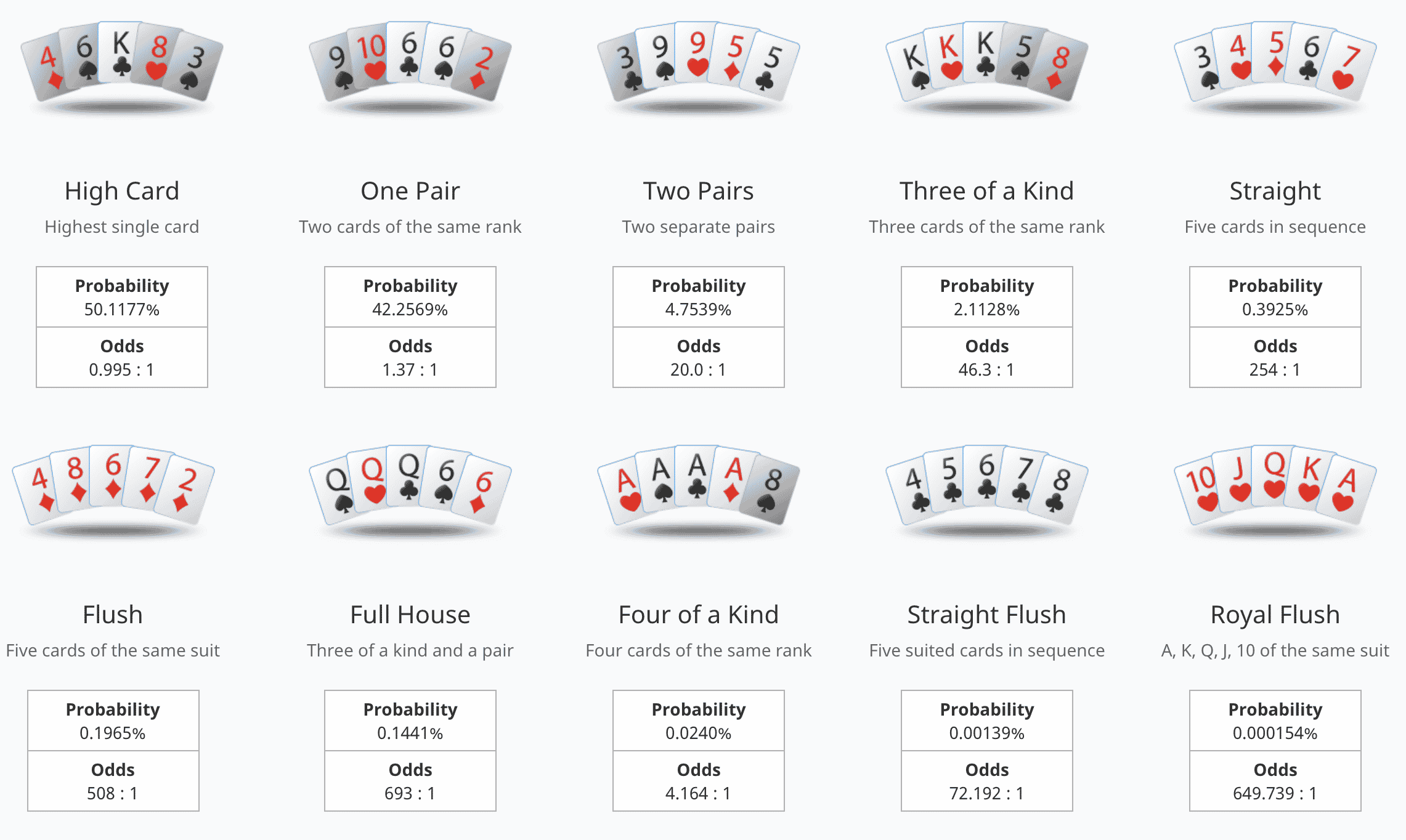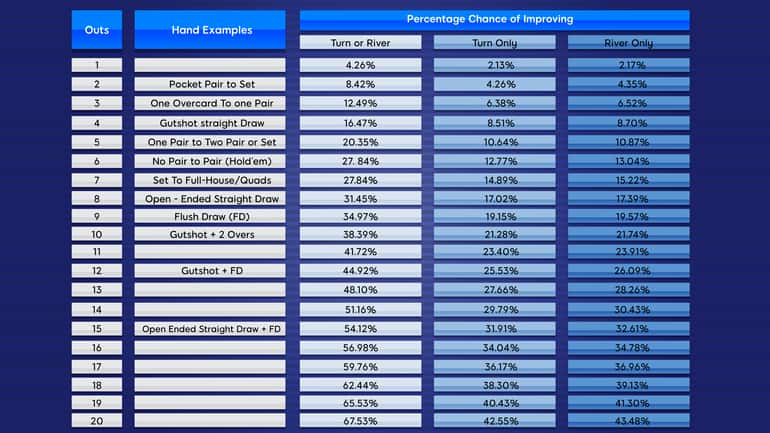Hands In Poker Odds
Calculating Hand Odds and Poker Odds Calculating hand odds are your chances of making a hand in Texas Hold'em poker. For example: To calculate your hand odds in a Texas Hold'em game when you hold two hearts and there are two hearts on the flop, your hand odds for making a flush are about 2 to 1. Poker odds calculate the chances of you holding a winning hand. The poker odds calculators on CardPlayer.com let you run any scenario that you see at the poker table, see your odds and outs,.
Understanding Poker Hands Odds
The Basics
Standard poker games like Texas Holdem typically use a single deck of 52 cards. Each card comes in four different suits. With this information, it would be possible to know exactly what your odds of getting specific cards or hands are. For instance, your probability of getting dealt any single card is 1/52. Your chances of getting an 8 (regardless of suit), on the other hand, is 4/52. Of course, the odds of getting different combinations of different cards would require more complex mathematical formulas, but the numbers can definitely be computed for.
Keep in mind, however, that knowing these numbers will not automatically make you an awesome poker player or guarantee that you’ll win every game. After all, aside from knowledge, experience and skill, luck also largely affects your chances for victory. At the very least, though, a good understanding of how probability works in poker should help you gauge where you stand and make better decisions while playing.
Please note the following card references:


(h) Hearts (d) Diamonds (c) Clubs (s) Spades
The Relationship Between Odds and Future Cards
In the example above, we showed how your odds of getting any one card are 1/52. But what if you already had one card in hand? Well, your chances of getting any other single card of a different value become 1/51 because there are only 51 cards left in the deck. Needless to say, your odds of getting any third card of yet another value are 1/50.
Same valued future cards are a completely different story, however, because aside from just removing one more card from the deck, getting a second, third or fourth card of the same value also keeps removing cards from the four total available in the deck. For example, if your odds of getting a 10, based on the second example in the first section, are 4/52, then your chances of getting a second 10 are 3/51. Your odds of being dealt a third and fourth 10 are 2/50 and 1/49 respectively.
The Science Behind Odds of a Hand
Your chances of getting any two cards of different values but specific suits as in 10s 4c (regardless of the order in which they are dealt), on the other hand, are 1/1,326. Here’s the math behind it:
P = 1/52 x 1/51 (because you’re getting one card and then one more future card)
P = 1/2,652
But since the two cards can be dealt in two ways (i.e., A then B or B then A), then we need to multiply the result above by 2:
P = 1/2,652 x 2
P = 1/1,326
For pairs, however, we’ll need to tweak the math a little bit:
P = 4/52 x 3/51
P = 1/221
Applications
Now that you know the basics of probability computations and how future cards affect them, you can easily figure out the probability of getting any number of poker hands. Let’s take a look at some examples:
To know your odds of getting a two pair, the computation is as follows:
P = 1/221 + 1/221 (because the probability of getting a single pair is 1/221 and we need two)
P = 2/221 or 1/110
For a set of cards of random values and suits as in A 10, on the other hand:
P = 4/52 x 4/51(4 because each card comes in for suits and we need both to complete the set)
P = 4/663 (or 2/13 if the order in which the cards are dealt in does not matter)
Some Tools You Can Use
Now, while you could do all these computations on paper (or in your head if you’re really good with numbers), there are some online tools that you can use to make things so much easier.
First up: a fraction calculator. It also comes with some other useful extras that allow you to simplify mixed fractions, convert decimal numbers into fractions and convert fractions into decimal numbers. It should make solving probability equations a breeze.
There’s also a tool you can use to reduce the resulting fractions into their lowest forms, which you can check out here.
Or if you don’t want to do the computations yourself, then you can just check out the numbers here. After all, you’re here because you’re looking for ways to improve your game and not to become a math whiz, right?
Now, while we’re on the subject, there’s really no better way to get better at poker than by actually playing it. So, why not sign up for a www.safeclub.com account today so you can start enjoying some real money poker action online? We’ll even throw in more of these poker tips in the package so you can keep getting better while you play!
Understanding Poker Hands Odds
The Basics
Standard poker games like Texas Holdem typically use a single deck of 52 cards. Each card comes in four different suits. With this information, it would be possible to know exactly what your odds of getting specific cards or hands are. For instance, your probability of getting dealt any single card is 1/52. Your chances of getting an 8 (regardless of suit), on the other hand, is 4/52. Of course, the odds of getting different combinations of different cards would require more complex mathematical formulas, but the numbers can definitely be computed for.
Keep in mind, however, that knowing these numbers will not automatically make you an awesome poker player or guarantee that you’ll win every game. After all, aside from knowledge, experience and skill, luck also largely affects your chances for victory. At the very least, though, a good understanding of how probability works in poker should help you gauge where you stand and make better decisions while playing.

Please note the following card references:
Odds On Hands In Poker
(h) Hearts (d) Diamonds (c) Clubs (s) Spades
The Relationship Between Odds and Future Cards
In the example above, we showed how your odds of getting any one card are 1/52. But what if you already had one card in hand? Well, your chances of getting any other single card of a different value become 1/51 because there are only 51 cards left in the deck. Needless to say, your odds of getting any third card of yet another value are 1/50.
Same valued future cards are a completely different story, however, because aside from just removing one more card from the deck, getting a second, third or fourth card of the same value also keeps removing cards from the four total available in the deck. For example, if your odds of getting a 10, based on the second example in the first section, are 4/52, then your chances of getting a second 10 are 3/51. Your odds of being dealt a third and fourth 10 are 2/50 and 1/49 respectively.
The Science Behind Odds of a Hand
Your chances of getting any two cards of different values but specific suits as in 10s 4c (regardless of the order in which they are dealt), on the other hand, are 1/1,326. Here’s the math behind it:
P = 1/52 x 1/51 (because you’re getting one card and then one more future card)
P = 1/2,652

But since the two cards can be dealt in two ways (i.e., A then B or B then A), then we need to multiply the result above by 2:
P = 1/2,652 x 2
P = 1/1,326
For pairs, however, we’ll need to tweak the math a little bit:
P = 4/52 x 3/51
P = 1/221
Applications
Now that you know the basics of probability computations and how future cards affect them, you can easily figure out the probability of getting any number of poker hands. Let’s take a look at some examples:
To know your odds of getting a two pair, the computation is as follows:
Odds Of Hands In Poker
P = 1/221 + 1/221 (because the probability of getting a single pair is 1/221 and we need two)
P = 2/221 or 1/110
For a set of cards of random values and suits as in A 10, on the other hand:
P = 4/52 x 4/51(4 because each card comes in for suits and we need both to complete the set)

P = 4/663 (or 2/13 if the order in which the cards are dealt in does not matter)
Some Tools You Can Use
Now, while you could do all these computations on paper (or in your head if you’re really good with numbers), there are some online tools that you can use to make things so much easier.
First up: a fraction calculator. It also comes with some other useful extras that allow you to simplify mixed fractions, convert decimal numbers into fractions and convert fractions into decimal numbers. It should make solving probability equations a breeze.
There’s also a tool you can use to reduce the resulting fractions into their lowest forms, which you can check out here.
Or if you don’t want to do the computations yourself, then you can just check out the numbers here. After all, you’re here because you’re looking for ways to improve your game and not to become a math whiz, right?
Now, while we’re on the subject, there’s really no better way to get better at poker than by actually playing it. So, why not sign up for a www.safeclub.com account today so you can start enjoying some real money poker action online? We’ll even throw in more of these poker tips in the package so you can keep getting better while you play!